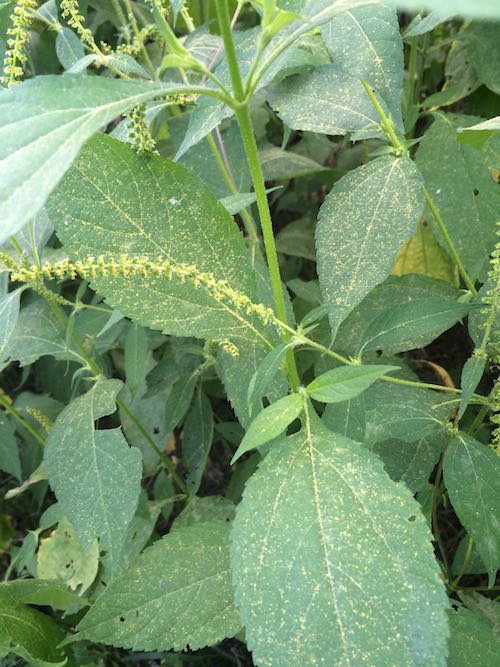Crow’s Nest: Plants We’d Prefer to Dislike
By Daniel Barringer, Preserve Manager
Or if you’d rather (but I don’t), “Plants we love to hate.”
It is ragweed season, and many of us are suffering grievously. My ragweed allergies are bad the last two weeks in August, peaking around September 1, and gradually improving after that even before first frost. Loss of sleep, sneezing fits, swollen nasal passages, itchy eyes, and some years culminating in a bronchial infection. I have to wear a mask when mowing or weed whipping, drive with the windows up, remove my clothing and shower when entering the house, which is also closed up for the duration of the wind-dispersed pollen season. But it’s nothing personal, and I bear the plant no malice. The flowering is far enough along now that a good rain would wash the air—too bad that’s not forecast.
Goldenrod often gets blamed for allergies, but its showy flowers are insect-pollinated, with larger pollen that sticks to the insect. It doesn’t blow in the air like ragweed, but because it is showy and blooms at the same time as ragweed it often takes the blame.
We have (at least) two species of ragweed around here, giant ragweed (pictured, Ambrosia trifida—taller than me, with three-lobed leaves) and common ragweed (Ambrosia artimisiifolia—shorter, and having finely divided leaves like artemisia, or wormwood). I like it when the Latin names are so transparent, as it is with the specific epithet of these two plants. But how’d it get its genus name, ambrosia, the mythological food or drink of the Greek gods?
(Also, just how often do you see words with two “i’s” together?)
Both are likely native species here—and invasive in other parts of the world. I haven’t done the research on what insects and other wildlife make use of this plant for food or cover but certainly some do. It is also pretty (at least giant ragweed is, in my opinion) and grows well on disturbed sites. For us it is primarily a weed of field edges, woods edges, roadsides, and around the edges of our yards where we have removed other invasive plants.
Note the pollen fallen on the leaves of the plant, below. But the pollen is also very light and easily becomes airborne.

Also note that some studies suggest that since ragweed is a carbon limited plant—that is, its growth is limited by how much carbon is available in its environment—its growth may be greater in a world with more carbon available in the atmosphere. See http://www.annallergy.org/article/S1081-1206(10)62009-1/abstract?cc=y=, an article by Peter Wayne PhD et al in Annals of Allergy, Asthma, and Immunology, March 2002, Volume 88, Issue 3, Pages 279–282, that states that in greenhouse testing, “[a] doubling of the atmospheric CO2 concentration stimulated ragweed-pollen production by 61% (P = 0.005).”
That’s nothing to sneeze at.

